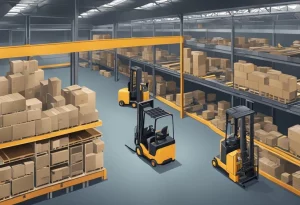Heavy machinery refers to equipment utilized in construction, mining, agriculture and other demanding operations. These machines are specifically designed to tackle tasks that would be too challenging or even impossible for humans to handle independently. Examples of machinery include excavators, bulldozers, cranes, loaders and more.
The notable feature of machinery lies in its size and weight. Generally speaking these machines are considerably larger and heavier compared to types of equipment. Operating them safely and efficiently requires training and expertise. Skilled operators of machinery must navigate spaces, maneuver through difficult terrains and work, under hazardous conditions.
Despite their imposing nature and complexity heavy machinery plays a role in industries. Without these machines many construction projects, mining operations and agricultural activities would simply be unattainable. As technology continues to advance heavy machinery is also becoming increasingly sophisticated and efficient—enabling levels of productivity and precision.
Different Categories of Heavy Machinery
Heavy machinery is a term used to encompass types of equipment employed in construction, mining agriculture forestry well as other sectors. The utilization of machinery has facilitated workers ability to accomplish tasks that were previously unfeasible, by manual means.
In this section we will explore the kinds of machinery and their applications.
Earthmoving Machinery
Earthmoving machinery is utilized for the purpose of relocating quantities of earth, rocks and other materials. This specific type of equipment finds use, in construction and mining operations. Examples of earthmoving machinery comprise bulldozers, excavators, backhoes and loaders. Bulldozers are employed for pushing and shifting volumes of earth. Excavators are utilized for digging and removing earth as rocks. Backhoes are employed for digging and raising materials. Loaders are used to transfer materials from one location to another.
Lifting Machinery
Lifting machinery is employed to hoist and transport objects. This category of equipment is commonly found in construction sites, manufacturing facilities and shipping operations. Cranes, forklifts and hoists are some examples of lifting machinery. Cranes play a role in lifting objects while ensuring their safe movement from one place to another. Forklifts are specifically designed to lift pallets well as other materials with ease. Hoists serve the purpose of lifting objects.
Hauling Equipment
Hauling equipment serves the function of transporting materials between locations. This type of equipment sees usage in mining activities, construction projects and agricultural settings. Dump trucks, trailers and conveyor belts are an examples, within this category. Dump trucks excel at carrying amounts of materials
Trailers are commonly utilized for the transportation of machinery and materials while conveyor belts are employed to efficiently move materials from one location to another.
Road construction machinery plays a role, in the creation and maintenance of roads. This type of equipment is widely used in both the construction and transportation industries. Some examples include asphalt pavers, rollers and graders. Asphalt pavers are specifically designed to lay asphalt on roads while rollers are responsible for compacting the asphalt. Graders on the hand are utilized to ensure a level road surface.
In summary heavy equipment serves as a component in industries. Each type of equipment has its specific purpose and function. By having an understanding of these types workers can effectively select the appropriate equipment for each task at hand ensuring efficient and safe completion.
Safety measures and Equipment Maintenance
Prioritizing Safety
When operating equipment it is paramount to prioritize safety at all times. Operators should strictly adhere to established safety protocols in order to mitigate accidents and injuries. These protocols commonly involve wearing gear (PPE) conducting thorough equipment inspections prior to usage as well as following proper lockout/tagout procedures when necessary. Furthermore providing training on safety protocols, for all workers involved is crucial to ensure they are well informed about hazards.
Maintaining Heavy Equipment
maintenance is of importance when it comes to ensuring the seamless operation of heavy machinery and avoiding unexpected breakdowns. Operators should adhere to the maintenance procedures recommended by the manufacturer, which include tasks, like checks and changes, inspection and replacement of worn out parts well as lubrication of moving components. By following these maintenance practices equipment lifespan can be extended while preventing repairs.
Training for Equipment Operators
Thorough training is a requirement for operators dealing with equipment in order to guarantee safe and efficient operation. Operators should undergo training specific to the equipment they will be handling, alongside general safety protocols. Continuous training sessions and periodic refresher courses are also beneficial, in keeping operators informed about the safety measures and maintenance procedures.
In conclusion prioritizing safety measures and implementing maintenance routines are aspects when working with heavy machinery. By adhering to safety protocols conducting upkeep activities and providing comprehensive operator training potential accidents can be minimized while ensuring optimal performance of the equipment.
More Stories
Top eSIM Providers for Europe Travel in 2025: Compare Plans & Prices
As global connectivity continues to evolve, eSIM technology has emerged as a game-changer for travelers, offering seamless access to mobile...
Precision Technologies International: Best Innovation Partner
Precision Technologies International (PTI) is the front-end transformer of many industries through innovative solutions. As day and night mark another...
Understanding Cybersecurity Risks: A Comprehensive Guide
In today’s interconnected world, cybersecurity is no longer an optional consideration—it’s a necessity. With businesses, governments, and individuals increasingly relying...
Unlocking Efficiency: How Contract Management Systems Enhance Business Operations
In the ever-evolving business landscape, maximizing efficiency is paramount. With organizations facing mounting complexity and competition, streamlining contracts processes and...
Understanding the CDK Cyber Attack: Implications, Causes, and Future Cybersecurity Threats
In recent years, cybersecurity has become a top priority for businesses and organizations worldwide. The digital landscape is continually evolving,...
Unveiling Crypto-Legacy.App Software: The Future of Cryptocurrency Management
In the rapidly evolving world of cryptocurrency, innovative software solutions are crucial for investors and traders alike. One of the...

